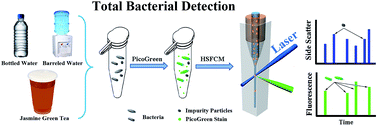Rapid detection and enumeration of total bacteria in drinking water and tea beverages using a laboratory-built high-sensitivity flow cytometer†
Abstract
Safe and secure supply of drinking water is an essential requirement for human health. Because many different microbiological contaminants may occur in drinking water and beverages, the total bacterial count represents one of the key parameters for quality assessment. Flow cytometry has been recognized as a rapid cultivation independent tool to assess the bacteriological quality and biological stability of water. Yet the limited detection sensitivity and the high background signal generated by impurity particles in the sheath fluid make data analysis difficult to perform, particularly for bacteria of small sizes. Using a laboratory-built high-sensitivity flow cytometer (HSFCM) with enhanced sensitivity and significantly reduced background signals of impurity particles, here we report the development of a rapid approach for the accurate quantification of total bacterial cells in drinks. Bacteria in drinking water and tea beverages were stained with PicoGreen nucleic acid dye, and both the side scatter and fluorescence signals of individual bacterial cells were detected simultaneously using the HSFCM. Using bottled drinking water and filtered tea beverage artificially contaminated with E. coli ER2738 as the model system, good correlations (R2 > 0.995) between the results measured by HSFCM enumeration and the traditional plate-counting method were obtained. The established approach was successfully applied to total bacterial quantification in barreled drinking water and Jasmine Green Tea beverages. Addition of 1 mM EDTA (chelating reagent) to tea beverage can efficiently block the interference of magnesium ions (Mg2+) on PicoGreen fluorescence staining. Compared with plate counting, HSFCM not only shortens the analysis time from days to less than 20 min, but also reveals the presence of dead and viable but non-cultivable (VBNC) bacterial cells. Therefore, HSFCM holds great potential in the rapid and accurate screening of the presence of bacteria in drinking water and tea beverages.


 Please wait while we load your content...
Please wait while we load your content...